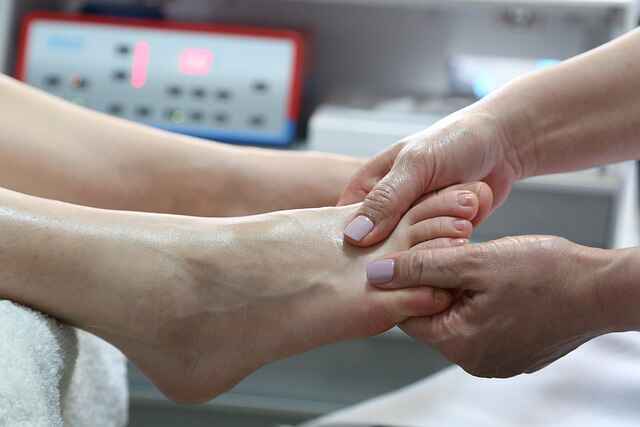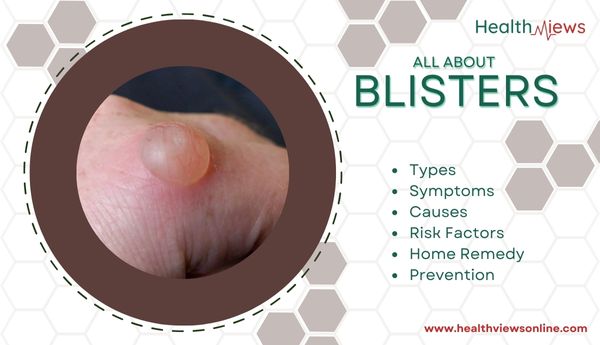What are Blisters?
A blister is a painful skin condition in which fluid fills a space between skin layers. They’re bubbles that form when fluid collects in pockets beneath your skin’s top layer. They can be filled with pus, blood, or serum, a clear, watery component of your blood. The majority are circular. These blisters may itch or hurt a lot or a little depending on the cause. They can be seen as a single bubble or in groups.
Types of Blisters
- Blood Blister – Blood blisters are blisters that have a blood sac inside them. At first, these may appear as red, raised bumps. The color will darken to a deep purple over time. Blisters of this type can be painful and itchy.
- Friction Blisters – They are caused by rubbing against the skin repeatedly. These blisters contain clear liquid rather than blood.
- Heat blisters – They are caused by burns and sunburns. They may also occur as your skin warms up following frostbite (freezing of the skin and underlying tissues). Source
Also Read: All About Himalayan Keeda Jadi: Health Benefits, Uses & Nutrition
Causes
They are typically caused by skin damage caused by friction or heat. Blisters can also be caused by certain medical conditions.
Blisters are formed when the epidermis, the outermost layer of the skin, breaks away from the deeper layers due to injury.
They commonly appear in the following locations:
- hands
- fingers
- feet
- mouth
- near joints
- near bony parts of the body
Risk Factors
Blisters can develop as a result of friction, infection, or, in rare cases, a skin condition. These causes are:
- Cold sore
- Herpes simplex
- Genital herpes
- Impetigo
- Byrns
- Contact dermatitis
- Stomatitis
- Frostbite
- Shingles
- Dyshidrotic eczema
- Pemphigoid
- Pemphigus Vulgaris
- Allergic eczema
- Chickenpox
- Erysipelas
- Dermatitis herpetiformis Source

Also Read: Shilajit Healing Benefits: Health Facts, Precaution, and Side-Effects
Symptoms
Blood blisters resemble friction blisters in appearance and are elevated, fluid-filled sacs on the skin.
Blood blisters have a red fluid as opposed to the clear liquid found in friction blisters. Over time, the liquid turns from a pale red to a dark red tint.
The majority of blood blisters will irritate the area around the blister slightly. The action that initially led to the blister’s formation may have hurt the person.
Some symptoms include;
- Exuding pus.
- Swollen or red.
- It’s hot and hurts.
- You’re feverish.
- You have underlying medical issues, such as diabetes or circulatory issues.
- When it smells rotten.
Diagnosis
It can be identified by a medical professional after performing a physical examination and reviewing your medical history. They will want to ascertain whether an illness might be the source of the blisters if the cause is not obvious (such as an injury or friction). Additionally, your doctor can instruct blood tests and skin tests.
In cases of chronic or unexplained blisters, a doctor may need to investigate potential underlying causes. Some types of skin cancer resemble blood blisters.
If the doctor suspects that the blister is more than just a blood blister, he or she may order a biopsy.
Treatment
- Use soap and warm water to wash your hands and the blister.
- Iodine-swab the blister.
- Apply a topical antibiotic ointment, such as Neosporin or Bacitracin, after cleansing your hands and the wound.
- Rub alcohol on a sharp needle to clean it.
- Prick the blister with the needle several times close to the edge.
- Apply petroleum jelly or another ointment to the blister and wrap it in a nonstick gauze bandage.
Home remedies
Blisters frequently don’t need any extra care. To improve your comfort, lower your risk of infection, and hasten the healing process, you can perform a few things at home, such as:
- Use soap and water to clean the blister.
- Use an antibacterial cream.
- Bandage the blister to protect it.
- Replace the bandage every day and hydrate the region.
- An ice pack or cold therapy may help ease discomfort and swelling
- Use Aloe Vera gel
Also Read: Health Benefits Of Aloe Vera: Medicinal Uses, Precaution & Side Effects
Prevention
There are certain things you can do to reduce your chances of acquiring a blister, even though you can’t always anticipate an injury. These include:
- Wear shoes that fit you properly.
- Always put on socks when wearing shoes.
- When working, put on gloves for protection.
- Put on sunblock.
- Dress appropriately for the weather.
- If you have frostbite, elevate your body temperature gradually with lukewarm water. Source
Want to know about other skin disorders? Check out Skin Problems on Health Views Online.





